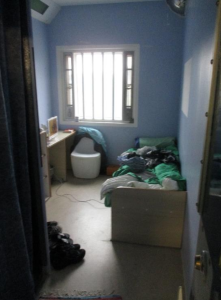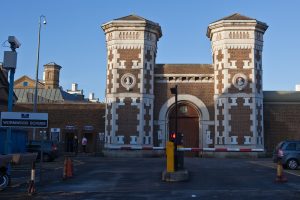Howard League blog · 23 Apr 2024
What IMBs tell us about prison today: Spring 2024 update
As we reflect on the first quarter of 2024, we turn again to the relentless endeavours of Independent Monitoring Boards (IMBs) in revealing the realities of life inside prison.
IMBs are critical to promoting accountability and transparency in the prison system. Boards comprise of volunteers who are appointed to monitor day-to-day life within prisons and immigration removal centres. They act as independent observers, conducting regular visits to prisons, and providing insight on the conditions and treatment of those detained through their annual reports.
Twenty IMB reports were published between January and March this year. They paint a vivid picture of the challenges of life in a prison which is desperately overcrowded. They demonstrate the many harms of soaring numbers of people entering jail and the inability to maintain adequate living standards. Notable in these reports is also the dearth of support for people with neurodiverse conditions in prison.
But before diving into these challenges, it’s worth setting out the context in which these 20 prisons are currently operating.
The government’s latest projections predict the prison population could increase by over 30% within the next four years. This feels unimaginable in a system already buckling under severe population pressures. IMB reports demonstrate what this means for the lives of people in prison – giving hundreds of examples of overcrowded cells, rising waiting lists for healthcare and resettlement activities, and overworked prison officers operating in understaffed institutions.
Staffing challenges were keenly felt in the children’s estate. At Cookham Wood prison, where 20% of officers resigned during the reporting year, the IMB found staff shortages in the face of a spike in prisoner admission caused inconsistency in regimes, with boys locked in their cells for up to 22 hours a day. The Board at Werrington prison reported that 17% of education classes were cancelled in the spring because there were not enough staff to host the rising numbers of prisoners. Since the report was published, Cookham Wood has been slated for closure, with more than half of the boys now moved out. It will reemerge as an adult men’s prison later in the summer.
These population projections are even more worrying in the face of high levels of ‘churn’ and late arrivals. Recent IMB reports show the detrimental impact this is having on reception and induction processes.
The influx of new arrivals in a prison, coupled with frequent transfers, places immense strain on existing resources and staff. This is made worse by the increasing frequency of late arrivals, largely due to court backlogs and an upwards trend of sentencing. HMP Bronzefield’s IMB show a monthly average of 10 late vans transporting people into prison at the start of their sentence – affecting nearly 60 women. HMP Ford’s IMB report over 120 movements in and out of reception at a time.
Late arrivals cause havoc in prisons. At Hewell prison, Board members found incredibly committed staff volunteering to stay beyond their shift to help manage the high level of admissions. Bronzefield’s IMB found late arrivals unable to make their reception phone call, get a hot meal, collect their property, or access the pastoral and practical support that should be available.
This influx not only disrupts the operational flow, but also impedes the timely provision of essential services, such as early healthcare checks. Board members found many people missed their healthcare assessment as a result of large groups arriving at once to Haverigg prison. Likewise, at Feltham, only 40% of arrivals received a healthcare screening within two hours of admission, against a national target of 95%.
Another concern highlighted by recent IMB reports is a sluggishness in addressing disrepair within prison buildings. People are increasingly being squeezed into jails that cannot cope with rapidly rising prison populations. Damage to living spaces and broken equipment is commonplace. And there are inevitable difficulties for officers in addressing these problems in good time, while managing growing lists of additional responsibilities due to depleting staff numbers. Bure’s IMB, for instance, say heating funding was provided pre-pandemic, but later lost due to the work not being completed, while the IMB at Wormwood Scrubs prison flagged the problem of broken lifts for several years in a row.
These delays not only compromise living conditions inside prisons, but also pose significant risks to the safety and wellbeing of those inside. At Channings Wood prison, the IMB flagged “…the excessive time taken to carry out some repairs to key buildings and equipment…adversely affects not just living conditions for prisoners but also access to many of the activities which help prepare them for release”. Similarly, the IMB at Ford give a troubling example of glacial repair work. Inspectors found several showers were out of order, but temporary showers were also found to be unfit for purpose, with intermittent temperatures and blockages that lasted for weeks.
We have long been aware of a significant number of people in prison with neurodiverse conditions. However, obtaining information on the number of people diagnosed has proven difficult, with no official statistics regularly published by the Ministry of Justice. On top of this, there are likely many more people who have not received a diagnosis. IMBs help provide a snapshot of this population in some prisons. In an encouraging development, Boards at the Verne and Hewell, for instance, identified 28% and 40% of the prison population as neurodiverse, respectively. The Board at Hewell concluded that the appointment of a neurodiversity manager, while a step in the right direction, “…has exposed a diversity of needs that cannot possibly be met within existing resources.” Cardiff’s IMB celebrate the opening of a neurodiversity hub in the prison last year. Similarly, a post to support this cohort was recently created at the Verne.
By fostering a more inclusive and understanding environment, prisons can better facilitate the rehabilitation journey for neurodivergent people and mitigate the risk of reoffending. It is great to see examples of emerging good practice in recent IMB reports. I applaud the prisons that have made efforts to support this group of people in extraordinarily difficult circumstances but there are severe limitations on adjusting the prison environment to meet the needs of neurodiverse people, and there are serious resource constraints. More of these initiatives are needed in our prisons, but fundamentally we need radical change to achieve diversion away from the criminal justice system in the first place.
The Howard League remains committed to lifting the lid on prisons and working towards driving positive change within the criminal justice system. IMBs play a critical role in helping us do just that, including by – as we have seen here – highlighting the need for timely repairs, streamlining the reception process, and prioritising support for the neurodiverse population. The effectiveness of IMBs relies entirely on the dedication and commitment of their volunteers; we can’t thank them enough.
Andrea Coomber KC (Hon.)
Comments
-
Join the Howard League
We are the world's oldest prison charity, bringing people together to advocate for change.
Join us and make your voice heard -
Support our work
We safeguard our independence and do not accept any funding from government.
Make a donation


Leave a Reply